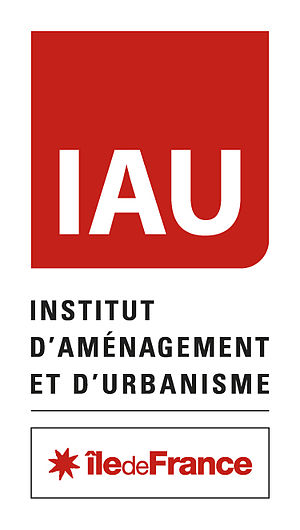Institut d'aménagement et d'urbanisme de la région de l'Île-de-France
| Institut d'aménagement et d'urbanisme de la région de l'Île-de-France (IAU) | |
|---|---|
| founding | May 4, 1960 as "Institut d'aménagement et d'urbanisme de la Région parisienne (IAURP)" |
| development | August 2, 1960 : Recognition as "important to the public" 1976 : Name change to "Institut d'aménagement et d'urbanisme de la Région d'Île-de-France (IAURIF) 2008 : IAURIF changes its logo and name: Es becomes IAU Île-de-France |
| initiator | Paul Delouvrier |
| legal form | Establishment of Public Interest |
| slogan | "Public spaces need ideas" ( Les espaces ont besoin d'idées ) |
|
business seat |
Paris , Île-de-France (France) |
| business management |
President: Jean-Paul Huchon General Manager: Valérie Mancret-Taylor |
| of activity areas |
Urban development (planning, environment, settlement, housing), questions of financing and administration, economic development, planning aid for traffic, safety, health, sport |
| organization | Organizational scheme |
| Website | www.iau-idf.fr |
The Institut d'aménagement et d'urbanisme de la région de l'Île-de-France (IAU) is a public law foundation whose task corresponds to an agency for urban development in the region of Île-de-France .
The facility operates both in France and internationally.
history
The institute was for a decree ( decree ) of 4 May 1960 under the name IAURP (Institut d'aménagement et d'urbanisme de la Région Parisienne) one on the occasion of the first generation development plan for the Ile de France created. Paul Delouvrier , who at the time was a member of the Paris Region District Council and then Prefect and Vice President of the Directorate for Development of the Area, is seen as the father of both the Ville nouvelle and the IAURP.
The IAURP became the IAURIF (Institut d'aménagement et d'urbanisme de la région d'Île-de-France) in 1976 . In 2008 the logo and the lettering were changed and the facility is now called IAU Île-de-France .
On August 2, 1960, it was recognized as being in the public interest and (since 1983) it was subordinated to the Regional Council of Ile-de-France . Thus, the President of the Regional Council is also the Chairman of the IAU.
organization
activities
The IAU prepares studies on French and international urban development, gives technical support to the Conseil régional d'Île-de-France and maintains a public documentation center. It is divided into different departments that deal with the following fields:
- Urban planning and spatial planning
- Demography , settlement geography , equipment, administration, finance
- Economic issues and local development
- Environmental issues and sustainable development
- Mobility and Transportation
- Questions about (public) safety
- municipal health policy
- municipal sports policy
- Information technology and geographic information systems
- international actions
The major spatial planning changes within the Île-de-France over the course of time were designed and designed by the IAU ( Ville nouvelle , RER , regional nature parks, etc.)
The IAU has accompanied more than 50 studies at international level.
Board of Directors
The IAU is led by a board of directors of 26 members, chaired by the respective president of the regional council of Île-de-France.
General Directors
The general directors at the top of the IAU Île-de-France had all graduated from the École des Ponts ParisTech by 2004 ; they were thus in the tradition that the state wanted so before decentralization.
The last general directors were:
- Pierre Pommellet (1982-1993)
- Jean-Pierre Dufay (1993-2002)
- Hervé Gay (2002-2004)
- François Dugeny (2004-2014)
Valérie Mancret-Taylor is currently the General Manager. She has the degree with the title of state-certified architect and urban planner, introduced in 1993
Seat
From 1990 to 1996, Le Monde magazine was also based at the institute's headquarters ( Paris, 15th district , 15 rue Falguière) . It is an old workshop building that was built after the war around 1950; after the workshop was abandoned, it became the property of the GAN insurance group and then the subject of an architectural competition (1988–1989) to redesign it. The architects Pierre du Besset and Dominique Lyon rebuilt it in 1990 and redesigned it in 1998. You use two free levels that are illuminated by a light shaft in the middle. The facade is adorned with curved glass with a radius of 42 m.
Publications
The IAU Île-de-France publishes the results of its work in various publications:
- Les Cahiers
- Les Note rapidly
- Les Atlas
- Les Carnets pratiques
- Les Mémentos de l'environnement
- Les rapports d'études
- Le site internet
- La newsletter mensuelle
- The key figures together with the Chamber of Commerce of the Île-de-France region and the Institut national de la statistique et des études économiques Île-de-France.
Web links
Individual evidence
- ↑ The French legal form largely corresponds to the foundations under public law under German law.
- ↑ Read on the website ( Memento of the original from December 29, 2015 in the Internet Archive ) Info: The archive link was inserted automatically and has not yet been checked. Please check the original and archive link according to the instructions and then remove this notice. the facility.
- ↑ See Décret en France on this
- ↑ To be found under schéma directeur de la Région parisienne.
- ↑ Read up in the history of the founding, 3rd paragraph ( Memento of the original from December 29, 2015 in the Internet Archive ) Info: The archive link was inserted automatically and has not yet been checked. Please check the original and archive link according to the instructions and then remove this notice.
- ↑ In France, certain institutions and / or foundations can be classified as Reconnaissance d'utilité publique , through which they can obtain special support.
- ↑ In France: Architecte et urbaniste de l'État
- ↑ 15, rue Falguière
- ^ The building of the magazine "Le Monde" in Paris
